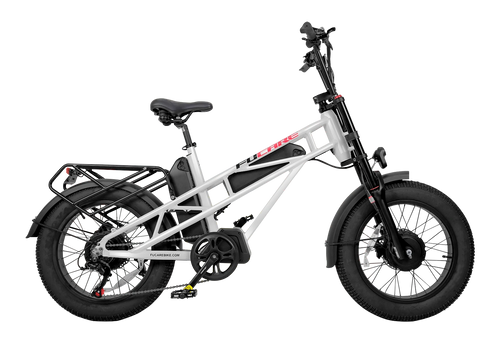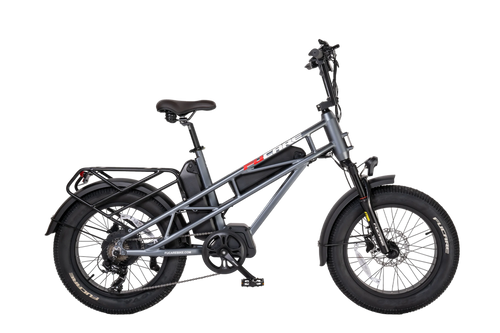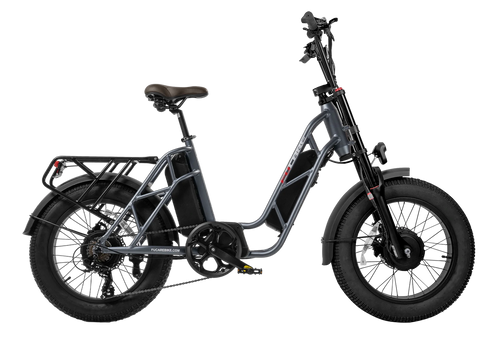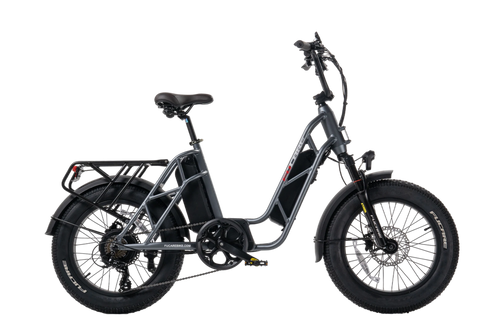How to Maintain Your Ebike

Diving into the world of electric bicycles, whether as a newcomer contemplating your first purchase or a recent enthusiast with one to call your own, understanding its upkeep is essential. By regularly cleaning and maintaining your e-bike, you ensure its operation remains efficient, smooth, and safe, thereby extending the life of both the vehicle and its critical components like the battery and motor.
In this guide, we'll walk you through everything you need to know to keep your e-bike in tip-top shape, from the basics of giving it a good wash to the nitty-gritty of lubrication, routine checks, and the latest in software and battery care. If you're wondering where to start, this friendly primer on e-bike care breaks down the essentials, steering you towards a smooth and enjoyable riding experience.
1. Regular Cleaning
Maintaining cleanliness is fundamental to your e-bike's longevity and performance. Regularly removing dirt and mud prevents the formation of a harmful paste, which, combined with water and grease, can decrease your bike's efficiency and hasten the wear on essential parts.
While e-bike motors and batteries are designed to be water-resistant, caution is advised against using high-pressure hoses. Such force could compromise the seals. Opt for a gentle rinse using a bucket or a hose with minimal pressure, complemented by a brush to effectively remove dirt. Drying off the bike post-wash is crucial to prevent rust.
Remember to keep the battery locked in place and ensure the e-bike system is powered down before cleaning. Also, disconnect any chargers.
2. Lubricate Your Chain Regularly

For optimal functioning, the moving parts of your e-bike, especially the chain, need regular lubrication. E-bike chains, under more strain than those on manual bikes, require frequent attention to keep the transmission running smoothly. Lubricating your chain after each ride, especially after cleaning and drying the bike, is a good practice.
3. Check the Tire Pressure
Regular checks on tire pressure are essential not just for safety but also for efficiency. Riding on under-inflated tires can lead to power wastage and diminish battery performance, while over-inflated tires may compromise your comfort and grip, affecting your experience, particularly off-road.
Regularly monitor tire pressure with a standard bike pump, adhering to the recommended pressure indicated on the tire's sidewall.
Additionally, keep track of your mileage to gauge tire wear. Generally, consider tire replacement after logging anywhere from 1,000 to 3,000 miles, depending on your riding frequency and terrain.
4.Regular Brake Checks

E-bikes require sufficient braking force to ensure safety.
Make it a habit to inspect and fine-tune the brakes regularly. Prior to setting out, scan for evident problems such as loose components or significant wear on both rotors and pads. Engage in an in-depth review of your brakes after each journey.
Promptly changing brake pads and rotors is crucial. Look to the e-bike manufacturer's specifications to understand the level of wear indicating it's time for replacements.
5.Charging and Storing the Battery
E-bike enthusiasts are always curious about the distance they can cover before their battery needs recharging. Charging your battery efficiently and is key to maximizing your journey. The strategy to enhance your electric bike's battery range is quite straightforward:
Whenever possible, give your battery a boost. These batteries are designed for numerous recharge cycles, allowing even frequent riders years of usage before a replacement is required. Therefore, please feel free to charge the battery at your convenience.

It's advisable to charge the battery in an environment that is both temperate and dry. To prolong your battery's life, it's best to avoid leaving it either fully charged or completely depleted for extended periods.
If you can remove your ebike's battery, keeping it indoors when not in use is wise. For storage over extended periods, aim for a battery charge level between 30% and 60%. Also, bear in mind that e-bike batteries, typically lithium-ion, are susceptible to rapid discharge in cold conditions, so it's preferable to store your battery in a place that's cool, dry, and shielded from direct sunlight.
Using the appropriate charger is crucial. Even if other chargers seem to fit, it's important to use the one specifically designed for your bike. Batteries have unique charging protocols, and an incompatible charger could potentially harm your ebike's battery.
6.Tighten Loose Components
Despite diligent inspections and upkeep, it's common for e-bikes to have parts like small screws gradually loosen, especially following rides on uneven paths.
It's wise to examine essential parts, such as brake levers and control knobs, for any looseness at least once every week. Plastic parts, in particular, are susceptible to loosening. Also, keep an eye out for wear indicators, like scratches and dents, which might signal underlying damage.
How Often Should You Maintain Your EBike?
Maintaining your bicycle regularly is essential, especially if it's an e-bike. You might be curious about the frequency of necessary upkeep after understanding the intricacies involved.
Before setting off on any journey, ensure these tasks are completed to guarantee your safety:
Inspecting tire pressure is crucial. An unnoticed tiny puncture or a slightly open valve cap could lead to a sudden loss of air. Always make it a point to verify the pressure in your tires before embarking on your ride.
Secure any components that are not tightly fastened. It's critical to ensure nothing wobbles or shakes. A brief inspection to confirm that everything from brake levers to electrical systems is firmly in place can prevent accidents.
Battery inspection is non-negotiable. The last thing you want is to find yourself stranded because the battery decided to quit. Always check the charge level before you start your journey.
Post-ride, it's just as important to clean your ebike. Accumulated debris like dust, mud, and pollen could hinder the performance of gears and other mechanisms. Always detach the battery before cleaning to avoid damage.

Regardless of the journey's length, always use a gentle cloth to clean your bike after. This ensures it remains in pristine condition, preserving its luster and functionality.
For those who rely on their e-bike regularly, a professional check-up and cleaning once annually is advisable, though more frequent visits may be necessary for avid cyclists. A good benchmark is servicing every 1,000 miles. Thus, if your weekly mileage is between 100 and 150, scheduling maintenance every three to four months is wise.
Consult the manual of your e-bike for specific maintenance schedules recommended by the manufacturer, as some have particular guidelines based on mileage.
Should any problems emerge or if your bike requires urgent repairs, do not hesitate to seek professional assistance immediately. It's better to address any concerns about the bike's condition or safety sooner rather than later, ensuring your rides are both enjoyable and secure.
Conclusion
As we conclude this in-depth exploration of ebike maintenance, it's clear that your commitment to proactive care will pay dividends in the longevity and efficiency of your electric ride. From proper battery charging practices to meticulous brake system checks, each component plays a vital role in the overall performance of your ebike. The road ahead is brighter when you ride with confidence on a well-maintained and reliable electric companion.
Basic Electric Bike Maintenance Tips
Diving into electric bike maintenance ensures your e-bike remains efficient, smooth, and safe. Here's a concise guide to keeping your electric bicycle in peak condition:
Clean Regularly: Dirt and mud removal is essential to prevent wear. Use low-pressure water and a brush for cleaning, and dry the bike afterward to avoid rust. Ensure the system is off and the battery is secure before cleaning.
Chain Lubrication: Given the extra strain on e-bike chains, lubricate regularly to maintain smooth transmission, particularly after cleaning or riding in wet conditions.
Tire Pressure Maintenance: Check and maintain tire pressure as per the sidewall recommendations to enhance efficiency and battery life. Replace tires based on wear or every 1,000 to 3,000 miles.
Brake Inspection: Regularly inspect brakes for wear and adjust as needed for safety. Replace pads and rotors according to the manufacturer's guidelines.
Battery Care: Charge the battery as needed, avoiding full depletion or overcharging. Store in a cool, dry place, ideally at a 30-60% charge level for extended periods. Use the correct charger to avoid damage.
Tighten Loose Parts: Check and tighten loose screws and components weekly, especially after riding on rough terrain, to prevent damage and maintain safety.
Routine Checks: Before rides, ensure tire pressure is correct, components are secure, and the battery is charged. Clean your bike post-ride to keep it in good condition.
Professional Service: Regular maintenance, at least annually or every 1,000 miles, is recommended. For any concerns or repairs, seek professional help.
Following these basic maintenance steps will keep your electric bike reliable, safe, and enjoyable to ride.
FAQs
How often should I clean my e-bike?
Regular cleaning is recommended, ideally after every few rides or at least once a month.
Can I charge my e-bike battery overnight?
It's best to avoid overnight charging; instead, charge your battery when needed and unplug once fully charged.
What should I do if my e-bike has a software issue?
Check for available firmware updates and follow the manufacturer's instructions. If the problem persists, consult a professional.
How can I troubleshoot gear-shifting problems on my e-bike?
Ensure proper lubrication of the chain and check for any debris. If issues persist, consult your e-bike's user manual for specific troubleshooting steps.
Do I need to consult a professional for minor brake adjustments?
You can attempt minor brake adjustments yourself, but if you're unsure or encounter difficulties, seeking professional assistance is recommended.
Continue reading

How to choose commute ebike












